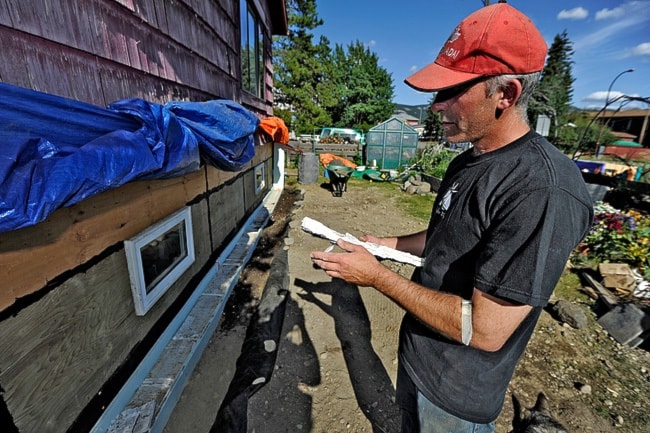Mitt Stehelin thanks you for recycling your Styrofoam products.
The Whitehorse resident is putting 2,800 pounds of the compressed material to good use by insulating the foundation of his new house with it.
Stehelin obtained the polystyrene foam from Raven Recyling, which only recently began accepting the material for recycling.
The depot uses an expanded polystyrene foam compressor to reduce the Styrofoam’s volume to one fiftieth of its original size.
After that, it’s normally shipped south to Westcoast Plastics in Richmond, B.C.
Ralph Charlton, operations manager at Raven, said that practice isn’t cost effective.
“We decided to let Mitt use some of the Styrofoam for his project because he has been a faithful supporter of Raven Recyling,” he said in an email.
“Ultimately, we would like to find a use for it here in the Yukon instead of paying shipping costs to send it south.”
The product was being compressed into nine-by-14 inch blocks and piled up onto pallets before being shipped.
Stehelin thought he could do something innovative with the Styrofoam, so he set out to determine its R-value, or the ability of a material to resist heat flow.
The greater the value, the greater the insulating power.
Stehelin’s problem was that he couldn’t find anyone local who could measure it.
He brought a sample to the Energy Solutions Centre as well as to the Yukon Science Institute but neither had the means to help him.
After doing some online research, Stehelin came across the website of a professor at the University of Oregon, Skip Rochefort, who had already done research on the subject.
He called the professor and left a message in the hopes of touching base with him.
“He called me back and was really enthusiastic about helping,” Stehelin said.
Rochefort uses an instrument that measures the thermal conductivity of materials, which is the inverse of thermal resistance.
“We can do this for all types of materials, such as wood, plastics and cement,” Rochefort said.
“We are looking at using recycled plastics as building materials in third world countries where they have a lot of plastic trash everywhere. The ultimate goal for us is to help them use these materials in their homes, which currently have no insulation at all.”
Raven Recycling and Stehelin sent him a fruit box full of Styrofoam to test.
It turns out it has an R-value of 4.1, which is close to the value of commercial compressed styrofoam, which has an R-value of five.
It would have cost him about $9.88 per cubic foot had he bought it brand new, Stehelin said.
He began insulating his foundation and quickly discovered he’d achieved an R-value of 47, plus the material that’s already in the wall.
He said the benefits go beyond the dollar savings.
“It’s also taking something that was normally thrown into the landfill and turning it onto a reusable item. It’s actually a quite effective tool as a green building material.”
To his knowledge, this is the first time recycled foam blocks have been used this way.
Stehelin said he would be finishing up the work on his foundation this week.
Contact Myles Dolphin at myles@yukon-news.com
